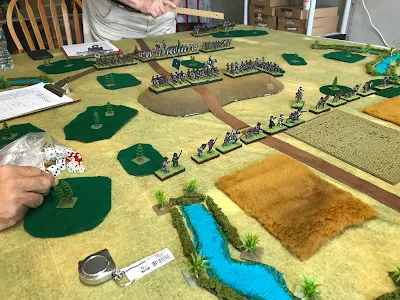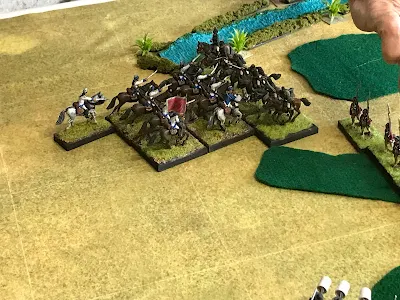After the Friday night club game John had enjoyed the rules so much he asked if I could put on a American Revolution game for our Monday morning get togethers. We both thought it would be a nice change from the usual Fire and Fury Civil War games. So I volunteered to put on The Battle of Cowpens.
Cowpens is one of the more interesting actions fought during the American Revolution. General Daniel Morgan with a mismatched command won one of the most decisive battles of the war. He understood how his opponent Banastre Tarleton fought and designed his battle plan for him. He understood the various strengths and weakness of each of his troop types (rifles, Continental line regulars and militia) and set them to maximize their strengths and off set their weaknesses.
In fighting I will used the historical order of battle at a 1:10 scale. The rules used are "Whites of Their Eyes" by Steve Haller. I limited the game to 12 turns to force the British to rush into the fight as historically they did. The battlefield was very slight rolling ground. There were scattered trees, mostly pines but they did not effect the fighting.
The British will enter the board in two lines. The first is made up of the 7th Regiment, Royal Artillery (3 pounder), British Legion Infantry and Light Infantry battalion. A troop of the Legion Cavalry and 17th Light Dragoons protect each flank.
The reserve was the Dragoons of the British Legion and the 1/71st Highlanders.
The British must attack and destroy the enemy as quickly as possible.
The British main line advances steadily but the American rifle men fire, cause some casualties and fall back. Although casualties are not heavy they are adding up. The Royal Artillery concentrates on the militia up on the hill with long range fire.
In these rules Skirmishers can use a split move. They can move part of their movement rate, fire and move the remainder. This tactic kept them away from the enemy while still causing casualties.
The rifles swung to both sides of the militia line. On the British left flank the commander orders the troop of Legion Dragoons to ride down the rifles. Although they do so, heavy fire from the militia on the hill wipes them out!
The 7th regiment decimated by rifle and musket fire fails morale and retired of the board. The 1/71st Highlanders move up to take their place. The South Carolina militia line holds steady and continues to fire at the enemy.
The Continental line says, aren't you guys supposed to fall back and let us do the fighting?
On the American left flank Tarleton orders the Region dragoons to charge and roll up the militia line. As they wade through A swampy stream waiting for them is Lt. Col. William Washington with mounted militia and Continental dragoons.
For the next three turns A wild cavalry meele ensures. First one squdroon of Legion dragoons are defeated. A second squadron throws back the Continental dragoons. Washington rallies them and back they go. Finally the British cavalry break and retreats off the board!
With his cavalry , the 7th and light infantry gone now Tarleton calls on the 1/71st to save the day. But the commander of the 71st tells Tarleton perhaps it is time to retreat and save what he can. While they may push through the militia there are too many. Continental waiting for them and cavalry ready to fall into their flanks. Tarleton reluctantly orders a retreat.
Once again we had a fun and fast moving game with these rules. By the third move of the game all players were running their troops with little help. Although simple they give a good feel for the period.
This one us a hard battle for the British to win. There are no sub commanders so Tarleton is kept busy trying to rally or encourage his troops. The Americans have lots of extra commanders to do this. In addition they have terrain on their side.
That said I was surprised the British just marched forward. The lights or legion infantry could have gone into Skirmishers formation to deal with the rifles. In addition throwing small groups if cavalry at bigger objects didn't b work well. Oh well perhaps next time.
----------
If you are untetested in refighting Cowpens here is the order of battle I used.
Cowpens Order of Battle
Morgan's Light Division
Cavalry Brigade: Lt. Col.Wm Washington
Continental Light Dragons (8)
McCall's Militia Horse (6)
Continental Brigade: Col. Howard
Maryland-Delaware Light bn. 30)
VA. State Troops (12)
Tripplett's VA. Rifles (12).
Militia Brigade: Pickens
1st Spartan SC militia. (24)
2nd Spartan SC militia (24)
(Hays Little River Militia Divided between the two militia regiments)
McDowell's Rifles. (12)
Cunningham's Rifles (12)
Tarleton's Flying Column
Lt. Col. Tarleton commanding
17th LD troop (4)
British Legion Troop (4)
Royal Artillery 3pounder
British Legion Infantry (20)
British Light Infantry (16)
7th Fusiliers (18)
1/71st Highlanders (30)
British Legion Dragoons (20)
(Light bn made up of light companies 71st regiment, and companies from the 16th Regiment and Prince of Wales American Regiment. A most unusual unit indeed!)




















Great game- and a fascinating battle. Having refought it a couple of times on the table, we had mixed results! Thanks for sharing.
ReplyDeleteThank you. Its a easy battle to set up but challenging to play. So far the American side has won each fight. We will be doing thus again in the future.
DeleteI have these rules and have never played them. You have whetted my interest, have to dust them off.
ReplyDeleteI look forward to hearing how it goes.
DeleteYes this is a hard scenario for the Brits, particularly with the extra little problems, like a single commander who cant be everywhere at once - but I think that might quite accurately represent Tarletons leadership style! I suspect Jonathon is going to employ a similar type of shoot and scoot tactic against Matt in the fourth version of his AWI scenario....
ReplyDeleteI planned to do exactly that but Matt killed my units before they had a chance to "scoot!"
DeleteIts a very hard nut for the British to crack IF you play historical. Tarleton was a one trick pony cavalry commander. When his surprise charge worked it was devastating. When the enemy was ready (See Blackstock) it worked not so good.
ReplyDelete